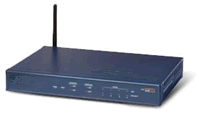 |
There
are currently three main standards for wireless
communication: HomeRF, Bluetooth, and 802.11b, an
extension of the standard also known as WiFi.
802.11b
is more expensive than HomeRF,
has conside- |
|
rably
greater range, and supports speeds up to 11meg/second.
There is a trade off between speed and distance as the
signal degrades the card drops speed to keep the
connection. Most manufacturers claim ranges up 500 feet
but environmental conditions can affect claimed
distances. |
|
|
The
802.11b is an IEEE standard, much like classic 802.3
Ethernet. This means that products from different
vendors are supposed to work reliably together. If all
the devices on your network are wireless, all you need
is |
 |
|
a
wireless NIC for each machine. Unlike Ethernet, no
central hub is required. This is called the
"ad-hoc" mode. |
|
If
you want to integrate wireless into an existing network,
you need to invest in a wireless access point to bridge
between the two. This is called an
"infrastructure" mode. Wireless technology
also offers exciting opportunities for bridging networks
and linking buildings without the need to lay fiber and
without the continuing costs of a leased line. |




